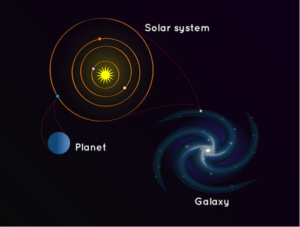About X-ray binaries
- The brightest X-ray sources in our galaxy are X-ray binaries.
- These X-ray binaries are two stars which rotate around each other.
- One of the two is a normal star; but the other is a collapsed star, such as a neutron star or a black hole, which has about the same mass as our Sun but has shrunk to ten kilometers or less in radius. Material is drawn from the normal star and spirals in via an accretion disk onto the compact star.
- Intense X-ray emission is released from the inner region of the accretion disk where it falls onto the collapsed star.
- The infalling matter releases gravitational potential energy, up to several tenths of its rest mass, as X-rays. (Hydrogen fusion releases only about 0.7 percent of rest mass.)
- The lifetime and the mass-transfer rate in an X-ray binary depends on the evolutionary status of the donor star, the mass ratio between the stellar components, and their orbital separation.
- An estimated 1041 positrons escape per second from a typical low-mass X-ray binary.
X-ray binaries are further subdivided into several (sometimes overlapping) subclasses
Classification by mass (high, intermediate, low) refers to the optically visible donor, not to the compact X-ray emitting accretor.
- Low-mass X-ray binaries (LMXBs)
- Soft X-ray transients (SXTs)
- Symbiotic X-ray binaries
- Super soft X-ray sources or Super soft sources (SSXs), (SSXB)
- Intermediate-mass X-ray binaries (IMXBs)
- Ultracompact X-ray binaries (UCXBs)
- High-mass X-ray binaries (HMXBs)
- Be/X-ray binaries (BeXRBs)
- Supergiant X-ray binaries (SGXBs)
- Supergiant Fast X-ray Transients (SFXTs)
Others
- X-ray bursters
- X-ray pulsars
- Microquasars (radio-jet X-ray binaries that can house either a neutron star or a black hole)
Galaxy
- A galaxy is a huge collection of gas, dust, and billions of stars and their solar systems. A galaxy is held together by gravity. Our galaxy, the Milky Way, also has a supermassive black hole in the middle.
- There are many galaxies besides ours, though. There are so many, we can’t even count them all yet.
- The Hubble Space Telescope looked at a small patch of space for 12 days and found 10,000 galaxies, of all sizes, shapes, and colors.
- Some galaxies are spiral-shaped like ours. They have curved arms that make it look like a pinwheel. Other galaxies are smooth and oval shaped. They’re called elliptical galaxies. And there are also galaxies that aren’t spirals or ovals. They have irregular shapes and look like blobs. The light that we see from each of these galaxies comes from the stars inside it.

















